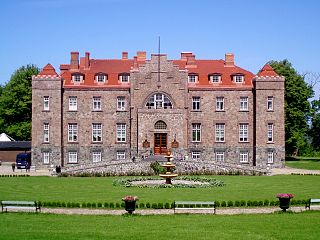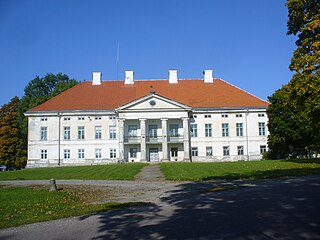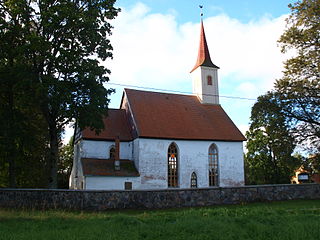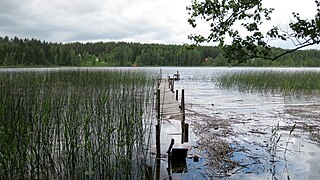
Tartu is the second largest city of Estonia, after Estonia's political and financial capital Tallinn. Situated 186 kilometres southeast of Tallinn and 245 kilometres northeast of Riga, the capital of Latvia. The distance to Estonia's summer holiday capital Pärnu in the west is 176 kilometres and the fastest route there by car is through Viljandi and Kilingi-Nõmme. Tartu lies on the Emajõgi, which connects the two largest lakes of Estonia, Lake Võrtsjärv and Lake Peipus. The city is served by Tartu Airport.

A municipality is the smallest administrative subdivision of Estonia. Each municipality is a unit of self-government with its representative and executive bodies. The municipalities in Estonia cover the entire territory of the country.

Emajõgi is a river in Estonia which flows from Lake Võrtsjärv through Tartu County into Lake Peipsi, crossing the city of Tartu for 10 km. It has a length of 100 km.

Aseri Parish was a rural municipality of Ida-Viru County in northern Estonia. It had a population of 1555 and an area of 67.14 km2 (25.92 sq mi).

Lihula Parish was a rural municipality in Lääne County, Estonia. It had a population of 2,652 and an area of 367.31 km2 (141.82 sq mi). In 2017, Lihula Parish, Hanila Parish, Koonga Parish, and Varbla Parish were merged to form Lääneranna Parish.

Rannu Parish was a rural municipality in Tartu County, Estonia. In 2017 it was merged into Elva Parish.
Rannu is a village in Viru-Nigula Parish, Lääne-Viru County in northeastern Estonia.
Kulli and Külli may refer to:

Kureküla is a small borough in Elva Parish, Tartu County, Estonia.
Väike-Rakke may refer to several places in Estonia:
Suure-Rakke may refer to several places in Estonia:

Verevi is a village in Elva Parish, Tartu County, in southern Estonia. It has a population of 38.
Rannu may refer to several places:
OÜ NG Investeeringud is an industry, retail trade and real estate investment group based on Estonian private capital, which employs more than 4300 people.

Ameerika Suvi is a 2016 Estonian comedy road movie directed by Rain Rannu, starring Einar Kuusk, Kristo Viiding, Helena Risti and Jarmo Murumaa. It is inspired by true events.

Elva is a rural parish in the Estonian Tartu County with an area of 650 km2 (250 sq mi). As of 2017, it has a population of 14241 inhabitants. It was created in 2017 from the merger of the municipality Elva with the rural communities Konguta Parish, Puhja Parish, Rannu Parish and Rõngu Parish.
Mati Ahven is an engineer and mechanic who was a member of the Estonian Supreme Soviet and a voter for the Estonian restoration of Independence.
Anna Henriette Leetsmann (1888–1942) was an Estonian Bolshevik activist, politician, educator and historian. She was the only woman elected to the Provincial Assembly of the Autonomous Governorate of Estonia in 1917, although she was expelled from the chamber in February 1919 after her Bolshevik activism during the period when Estonian communists, sponsored by the Soviet Union, de facto governed parts of Estonia. By that time, she had already lived in the Soviet Union since the German occupation of Estonia in February 1918; the rest of her life was spent teaching, studying and working for the party in the USSR. She was detained by the Soviet authorities twice for (allegedly) being a Trotskyist; she died during the second period of incarceration.
This page is based on this
Wikipedia article Text is available under the
CC BY-SA 4.0 license; additional terms may apply.
Images, videos and audio are available under their respective licenses.















